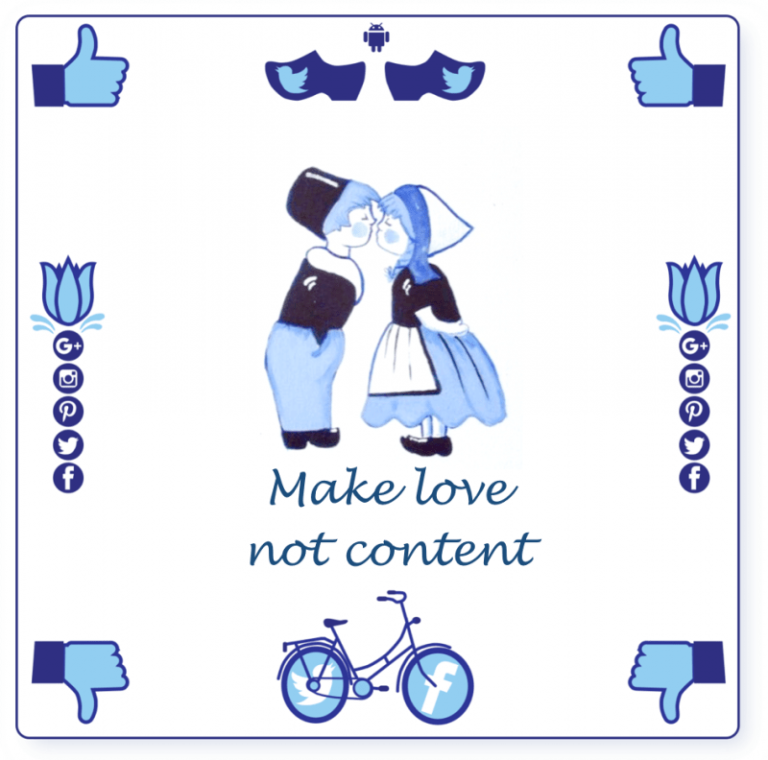
‘Make love not content’
In September I spoke at Content Marketing World. The world’s largest conference in content marketing. A crowded room and afterwards many warm reactions. “This is by far the most entertaining and meaningful presentation I attended. I left feeling empowered and encouraged to bring our brand and products alive through the stories of the people involved with what we do. Thanks for having him speak!’This article is a short summary of my talk at #CMWorld.
A few years ago, the communication manager at ProRail – a Dutch railway infrastructure company – asked me to help him with content marketing. He requested an editorial format and didn’t know where to find relevant stories. This last remark intrigued me.
Why did he have to look for stories? His organization was bursting with stories about the company and its people, waiting to be dusted off and told.
I uncovered a story about storks. Happily in love, the birds built a nest on an overhead line in Rotterdam. The nest’s faulty design was a risk. If it dropped, it would disturb train service. ProRail employees climbed up to remove the nest and replaced it with a sturdy and modern metal version. The lovebirds were not happy with this upgrade and moved out. But when ProRail employees added branches and twigs, they came back to their new and improved home.
I also discovered that ProRail builds wildlife crossings over top or underneath railways and highways to protect animals. And that employees plant wild flowers along the tracks and place insect hotels and hedgehog habitats in between the perennials.
ProRail’s story library was chockfull with remarkable stories that were never shared with the public.
Another example: ProRail has an in-house emergency service: the Accident Fighters. These are the people who are called to tend to railway collisions and other disasters. I had no idea. I always thought the good men and women of the Dutch firefighter and police department dealt with these incidents.
“We just do our job, you know, nothing special”, said a ProRail employee. And I wondered: where was the company pride. Where was the love and passion for the great things they were doing?
I decided to give the company’s communication department (a group of 20 people) an exercise. I asked them to write a personal ad for their brand. “Include things like your looks, your hobbies and interests”, I explained. “Describe the partner you are looking for. Are kids a deal breaker? What do you want to do on your first date?”
Everyone worked individually, but the descriptions were very similar and could be summarized as a ‘tough nut to crack’ male wearing a patterned dress shirt and dress pants. His summers are spent camping with his two kids – a boy and girl – somewhere not too adventurous and not too far from home. He would like to meet nice women who can cook and who love children. On a first date he’d like to take that special person to a Chinese or Indonesian restaurant in his home town.
All the descriptions followed this narrative, except one. Karel took a different approach: “He’s not looking for a woman”, he said, “but for a man.”
There was a moment where you could hear a pin drop. Then all hell broke loose and opinions and remarks were flying across the room. Eventually I quieted everyone down and said: “What I think Karel is trying to say, is that ProRail should come out of the closet. This company is too soft, too apologetic. It takes regular beatings from the media and the public. When projects are delayed for example, or when repairs go over budget. ProRail is passive.” I continued.
“So I wonder, where is your pride? Why don’t you step up and say: we are ProRail! We move 35 million Dutch commuters and travelers per month to and from places all over the country. Our railways are among Europe’s busiest transit systems. Some of the routes cope with 44 trains per hour. So yes, things might go wrong sometimes. That is inevitable.”
I kept going: “Instead, show passion when you talk about management and maintenance of railroads. Tell the tales of hedgehogs, storks, insects, flower seeds and accident fighters. Touch the public and fill their hearts with emotions. Look through the eyes of a child and see how wonderful your work is. I guarantee that the next time something goes wrong, they’ll judge you less quickly.”
Now, ProRail shares more videos. Their YouTube channel features a series with a kid reporter who tells stories from the world of ProRail. Now there is transparency about incidents or mishaps on the tracks. There is love. For and from the hardworking people of the Dutch railroads.
I told the ProRail story at a conference in the Netherlands. A marketing executive from USG Marcom approached me afterwards. USG Marcom is the largest placement agency for marketing communications professionals in the Netherlands.
She recognized USG Marcom in the ProRail story. “USG has no pride”, she said.
That didn’t surprise me. What should USG Marcom employees be proud of? USG Marcom had no story, didn’t stand for anything, didn’t stand apart from other placement agencies. Admittingly, the new CEO told some sort of story, but nobody knew or understood it.
I helped them find their story. Their market position, their distinction, their brand identity, their narrative. I defined this with the help from USG Marcom employees from all departments, not just the marketing people.
People are much more inclined to share stories if they are a part of it.
I visited Mechelen once, a gem of a town between Antwerp and Brussels. On the beautiful Grand Market, I was drawn to a little restaurant with ‘Unwined. Wines with a story’ written on the window. I just had to go inside, because I love a good glass of red and I love stories.
My wife studied the menu, I looked at the wine list.
We ordered a glass of red and a glass of white and I couldn’t wait to hear the stories of these wines. Upon asking, our server replied: ‘I only work here part time. I don’t know of any stories, but the sommelier might.’
That’s what she said, but she was probably thinking something else. Probably something like: ‘We write that stuff on the window to attract schlubs like you. It’s called marketing, you dummy.’
Many companies behave like ‘Unwined’. Marketing departments invent some story, place it on their website and make a big fuss about it. Employees are often not involved in writing this story, which is a big mistake. It’s the employees who will tell the story and it is key that they feel ownership of that story. Only when you have a well-defined storytelling and sharing culture within your company, you can spread the love.
The Rolf Group is a total provider for Kindergarten and primary education. They asked me to launch an editorial format where employees are telling stories. However, their employees were not used to telling stories and they found the whole idea terribly uncomfortable. I needed to create a storytelling culture first and after some inquiry, I picked a subject everyone enjoyed talking about: their hobby.
I visited all the company’s departments and interviewed the employees about their hobbies. I asked them how they found their hobby, what they got out of it and what they want to learn from it. This last question in particular was interesting because ‘learning’ is the DNA of TheRolf Groep-brand and should be at the heart of all the stories.
We published the stories in their online magazine and printed a separate booklet. People read it and it sparked conversations: ‘I didn’t know you played the tuba. So does my wife!’ or ‘Did you read the story about our skydiving CEO? What a champ.’
The Rolf Group established a culture where storytelling and sharing was the new normal.
Telling stories isn’t the privilege of a department. Stories are the engine of every company.
Many CEO’s are wondering how to tear down the silos in their organization. There are plenty blogs and articles that try to answer this question for you, but I think the answer is very simple. I wrote a book about content marketing called the Content Bible and even though it is not my habit to quote the Book of Books, Corinthians 13 holds the answer: love. That’s the key for tearing down those silos.
You have to have love for your colleagues, for your business, for telling stories.
Everything is useless without love.
Case in point is Deli XL, a Dutch food service company that recently changed it name into Bidfood. Six years ago they predominantly delivered meals to hospitals, but they wanted to increase their restaurant client base. In an attempt to do so, they started a video platform called Foodreporter.
VideospelerOn this platform they didn’t talk about themselves nor the products they sell.
“We wanted to put Dutch chefs on the international map”, explains Marco van Davenhorst, editor-in-chief of Foodreporter. “The platform’s entire focus is on chefs. We discuss food trends, rising stars in the industry, creative new dishes and ingredients. Why? Because DeliXL loves food.”
Did it work? Of course it worked. Just look at these numbers: 500,000 viewers weekly; 1500 new subscribers weekly; 300,000 videos watched each month; Live streams reached 150,000 fans.
DeliXL went from a 20% share in the restaurant industry to a 60% share by 2017.
Not a result of talking about what they make, but about what they make possible.
To be really effective with content, you can’t just throw a story online. Without love, your content is meaningless. You might gain short term success; a handful of new followers, a couple of thumbs up and an increase in RT’s. But if you tell real stories from the core and DNA of your company, you are being authentic and you’ll have long term success with your audience. Authenticity is always valued, and stories about your principles and your beliefs will resonate with your audience and you’ll create real connections.
So there you have it. The key to content is love. Not the bag of shouty tricks and pro-tips (i.e. Be your audience! Stand out! Think in narratives!) that show up after a quick Google search. You have to remember to act from your heart in everything you do. And don’t fake it, because people will notice.
You can’t inspire others when you’re not inspired yourself.
When stories (or poems, or novels or films) are filled with love they exude confidence. Great art, like good products or services, grabs your attention immediately and it whispers in your ear: I know what I am and I am going to blow your mind with a story that you’ll remember forever. Just trust me and join me on this journey. If the maker did not believe his own story, the feeling would be very different and you would lose interest quickly.
An audience immediately feels when they’re in good hands. And as soon as they feel that, they’ll trust you. And that’s all we want: to be trusted by our audience.
Foto: Ferry Damnman
When there is love and authenticity, you can set a hearts on fire.
I recently took my ten year old daughter toTyphoon, a Surinam/Dutchsinging sensation. The stadium was sold out and our seats were up high, far from the lively dance floor in the center. But what a show! I glanced at my daughter during songs and she was mesmerized.
“That man is a very nice man”, she said to me afterwards.
“How do you know?” I asked her.
“Because he sang for me. He really sang for me. I could feel it.”
It was love. The title of Typhoon’s tour wasLobi da Basiwhich means ‘love is the boss’ in the Surinam language. He told stories through his lyrics. He added love and he touched our hearts.
Typhoon got it right with his ‘content’ and he left his audience filled with emotions, wanting more. Simply because he made love, not content.
And you should do the same:
Make love not content.

